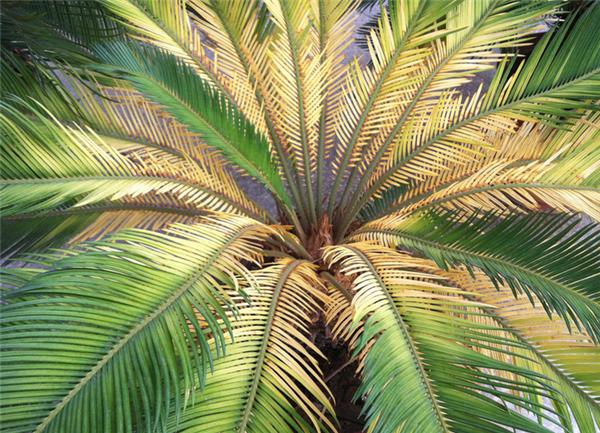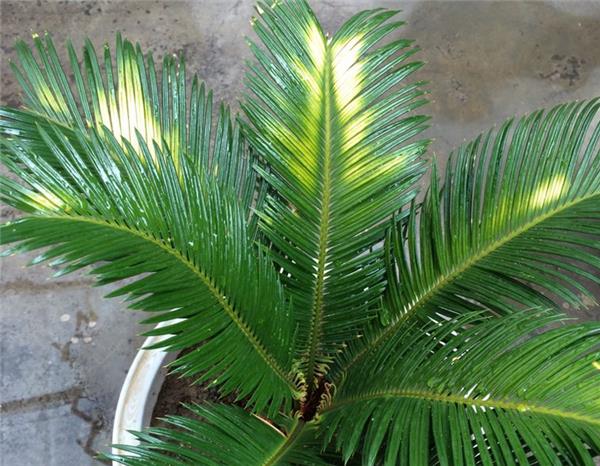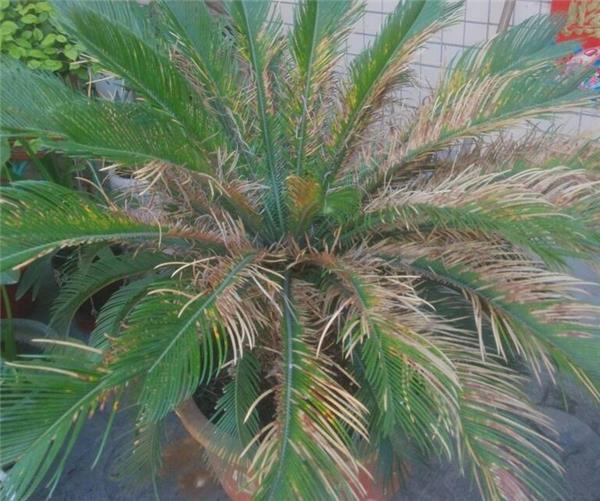The cause and solution of yellowing of Iron Tree leaves
Iron tree, also known as fire-avoiding banana, cycad, Phoenix-tailed banana, etc., grows relatively slowly, is a kind of light-loving plant, slightly tolerant to semi-shade, and is a very common green plant. Do you know what to do if the leaves of the iron tree turn yellow? Next, let's take a look at the causes of the yellowing of the leaves of the iron tree and its solutions.

The cause and solution of yellowing of Iron Tree leaves
1. Soil bias
Iron tree is suitable for slightly acidic sandy soil. Soil alkalization will lead to yellowing of iron tree leaves. It is necessary to irrigate basin soil with 500 times ferrous sulfate solution, once a week, several times continuously, which can improve the chromaticity of leaves.
2. Lack of light
Iron tree in the growth of new leaves must be protected by the whole sun, only the leaves hardened and then put in the semi-shade to appreciate, if the growth period can not have good light conditions, it will not grow satisfactorily.
3. Overwatering
Although the iron tree needs a lot of water in the new leaf growth period, it can not make the basin soil wet for a long time, otherwise the root system is easy to lack of oxygen, resulting in poor growth and leaf yellowing or ossification. Solution: control the water immediately.

4. Too little watering
Iron tree can also cause yellowing of leaves due to lack of water and drought. Its characteristic is that the old leaves are yellow first from bottom to top. If it is short of water for a long time, the whole plant will be yellow, or even die, so it should be watered in time.
5. Excessive fertilization
Iron trees can also cause yellowing of leaves due to excessive fertilization or high concentration; characterized by thick, shiny and uneven young leaves; fertilizer, ploughing and watering should be controlled.
6. Fertilizing too little
Iron tree due to lack of fertilizer, low fertilization concentration will also lead to yellowing leaves, and fertilization interval is too long; it is characterized by young leaves, tender stems first yellow, if you see this phenomenon after not timely fertilization, will also cause the whole plant yellow leaves or even death; for flowers lacking fertilizer, do not apply a large amount of thick fertilizer, so as not to cause root burning.
7. Diseases and insect pests
Diseases and insect pests are also the cause of iron tree leaves yellowing, pay attention to check whether there are insects on the leaves, such as red spiders, shell insects and so on. Can spray wind oil essence, washing powder solution 0.2% solution to eliminate. If the leaves have macula, yellow spots can be sprayed with garlic liquid or carbendazim for sterilization.

Finally, let's take a look at the cultivation method of iron tree.
1. Soil: potted iron tree is suitable for slightly acidic sandy soil with good drainage, loose and fertile soil.
2. Temperature: the iron tree likes to be warm, so it should be cooled by spraying water properly when it is hot in summer, and the room temperature should be kept at about 10 ℃ in winter. As the growth of the iron tree is relatively slow, the hot sun should be avoided in summer, otherwise it is easy to cause the phenomenon of scorched leaves and yellow leaves. The iron tree has strong cold resistance, but when the winter temperature is 0 ℃, it should move indoors or in a warm place to survive the winter.
3. Light: the iron tree can not be placed indoors for too long, because the iron tree likes the light, and the lack of light will make its new leaves sparse, thin and green. Therefore, the four seasons of iron tree breeding need to be placed in a sunny place, especially when new leaves grow in spring and autumn, they should be maintained in direct sunlight, and then move indoors to watch when the new leaves grow old.
4. Watering: iron tree is more resistant to drought, likes to dry and avoid dampness, and can generally be rewatered after the soil is dry. if it is watered too much, it is easy to rot roots and bad leaves. It is usually watered about 10 days in winter, 3-5 days in spring and autumn, and once in the morning and evening in summer. Watering should see dry and wet, iron tree basin soil long-term accumulation of water is too wet, will cause yellow leaves, rotten roots.

5. Fertilization: in the growing season of iron tree, topdressing should be applied frequently, mainly nitrogen and potassium fertilizer, and rotten cake fertilizer and water is the best. Fertilization should pay attention to the frequent application of thin fertilizer, do not be too thick. In order to promote the dark green and glossy leaves, an appropriate amount of ferrous sulfate solution can be added to the fertilizer. Fertilizing should pay attention to more vanadium fertilizer and water, or you can put some rust iron into the soil, or buy iron tree special fertilizer in the flower market, which can make the iron tree leaves dark green and glossy and improve the ornamental value.
6. Pruning: iron trees send out new leaves once or twice a year. In order to have a beautiful posture, the old leaves and withered yellow leaves of the next year should be cut off, and the leaves that are too dense or too long should also be trimmed according to the situation to keep the tree shape symmetrical.
7. Turn the basin: the basin should be turned every 2-3 years, and the suitable time is from March to April in spring. When turning or changing the basin, the withered roots and bad roots should be cut off, and the old soil of 1, 2, 2, 3 should be removed and replaced with fertile and loose new soil, so as to make the plant grow vigorously. At the same time, we should also pay attention to the empty basin floor to facilitate ventilation and water penetration.
9. Pest control: iron tree stalks with hard leaves and fewer diseases and insect pests. There may be the invasion of shell insects. When shell insects are found, they can be killed by manual washing. If the pest is serious, it can be irrigated with 1% ferrous sulfate diluent. It is worth noting that potted iron trees should be placed in a ventilated, transparent, hygienic and clean place, which can also effectively prevent the occurrence of diseases and insect pests.
Because there are many possibilities for the causes caused by yellowing of leaves, flower friends should not solve them blindly. They must carefully investigate, find out the causes of the problems, and check one by one from water, soil, fertilizer, and light.
9. Pest control: iron tree stalks with hard leaves and fewer diseases and insect pests. There may be the invasion of shell insects. When shell insects are found, they can be killed by manual washing. If the pest is serious, it can be irrigated with 1% ferrous sulfate diluent. It is worth noting that potted iron trees should be placed in a ventilated, transparent, hygienic and clean place, which can also effectively prevent the occurrence of diseases and insect pests.
Because there are many possibilities for the causes caused by yellowing of leaves, flower friends should not solve them blindly. They must carefully investigate, find out the causes of the problems, and check one by one from water, soil, fertilizer, and light.
Related
- Wuhan Hospital Iron Tree Blooming Result Was Instantly Frightened by the Gardener Master
- Which variety of camellia is the most fragrant and best? Which one do you like best?
- What is the small blue coat, the breeding methods and matters needing attention of the succulent plant
- Dormancy time and maintenance management of succulent plants during dormancy
- Minas succulent how to raise, Minas succulent plant pictures
- What are the varieties of winter succulent plants
- How to raise succulent plants in twelve rolls? let's take a look at some experience of breeding twelve rolls.
- Attention should be paid to water control for succulent plants during dormant period (winter and summer)
- Watering experience of twelve rolls of succulent plants
- Techniques for fertilizing succulent plants. An article will let you know how to fertilize succulent plants.



